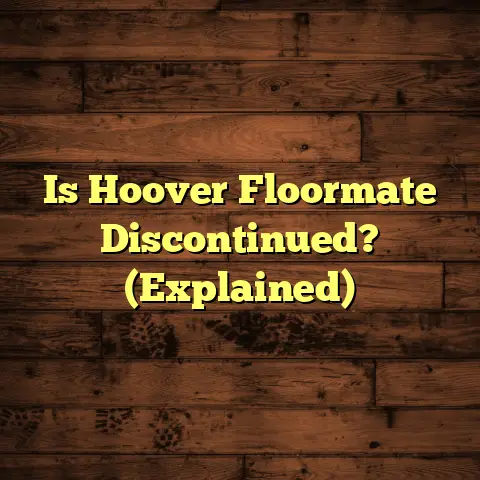Why Is My Wood Floor Slippery? (3 Grip Fixes NOW!)
As a flooring contractor for over 15 years, I’ve seen it all – from flooded basements to DIY disasters.
But one concern I hear time and again, especially from parents, is about slippery wood floors.
I get it.
You’ve got little ones running around, exploring every nook and cranny, and the last thing you want is for them to take a tumble on a slick surface.
Wood flooring is beautiful, no doubt.
It adds warmth and elegance to any home.
But let’s be honest, it can be a hazard, especially for those unsteady little feet.
That’s why I’m here to break down why your wood floors might be slippery and, more importantly, give you 3 grip fixes you can implement now to create a safer environment for your kids.
Let’s dive in!
Section 1: Understanding Wood Floor Slipperiness
So, what exactly makes a wood floor slippery?
It’s not just one thing, but a combination of factors.
Think of it like a recipe – the ingredients have to be just right (or wrong!) to create that slick surface.
Here are some of the usual suspects:
-
Type of Wood: Harder woods like Brazilian Cherry or Maple tend to be more dense and less porous than softer woods like Pine. This means they often have a smoother surface, contributing to slipperiness.
-
Finish: This is a big one! High-gloss finishes, while beautiful, create a very smooth, reflective surface. Polyurethane is a common culprit. On the other hand, matte or satin finishes offer more texture and grip.
-
Maintenance Practices: Believe it or not, how you clean your floors can make a huge difference. Using the wrong cleaning products (especially those that leave a residue) can create a slippery film.
-
Environmental Conditions: Humidity plays a role, too. In humid environments, wood can expand slightly, which can sometimes make the surface feel smoother.
Think about it: ever notice how your wood floors feel different in the summer versus the winter?
-
Wear and Tear: Over time, the finish on your wood floors can wear down, becoming polished and slippery from foot traffic.
But what does all this mean for your kids?
Well, according to the CDC, falls are a leading cause of injury for children.
And while I couldn’t find specific stats on falls on wood floors, it’s safe to assume that a slippery surface significantly increases the risk.
I’ve personally seen kids slip and slide on floors that look perfectly fine.
It’s not worth the risk, folks.
Section 2: The Importance of Safety for Children
Let’s talk about why kids are especially vulnerable to slips and falls.
It’s not just that they’re smaller; it’s also about their development.
-
Unsteady Gait: Toddlers, in particular, are still developing their balance and coordination. Their little legs are still learning to navigate the world.
-
Sudden Movements: Kids are notorious for their unpredictable movements. They might be walking calmly one second and then suddenly burst into a run, pivot sharply, or jump in the air.
-
Lack of Awareness: Let’s face it, kids aren’t always the most aware of their surroundings. They’re often focused on their game or their destination, not on potential hazards.
Creating a safe environment for children to play and explore is crucial for their physical and emotional development.
They need to feel free to move and discover without the constant fear of getting hurt.
I remember one time, I was working on a flooring project for a family with a toddler.
The mom was constantly hovering over her child, worried about him falling.
It was clear that the slippery floors were creating a stressful environment for everyone.
That’s why addressing this issue is so important.
It’s not just about preventing injuries; it’s about creating a more relaxed and enjoyable home life for your family.
Section 3: Evaluating Your Wood Floor for Slipperiness
Okay, so how do you know if your wood floors are actually slippery?
Here’s a simple assessment you can do right now:
-
The Sock Test: Put on a pair of socks (preferably cotton or wool) and walk around on your wood floors. Do you feel like you’re sliding more than walking? Do you have to grip the floor with your toes to maintain your balance?
-
The Shoe Test: Try walking on your floors with different types of shoes. Leather-soled shoes are notoriously slippery. Rubber-soled shoes should provide more traction.
-
The Wet Test: (Use caution!) Lightly dampen a small area of your floor with water. Walk on the damp area with your socks or shoes. Does it feel significantly more slippery than the dry area?
-
Visual Inspection: Take a close look at your floors. Are they highly polished and reflective? Do you notice any worn areas where the finish has been rubbed away? These are all signs of potential slipperiness.
I’ve even seen homeowners use a simple “slip meter” – a device that measures the coefficient of friction of a surface.
But honestly, the sock test and the shoe test are usually enough to give you a good idea of how slippery your floors are.
If you’re still unsure, ask a flooring professional to come and assess your floors.
We have the experience and the tools to give you an accurate assessment.
Section 4: 3 Grip Fixes NOW!
Alright, let’s get to the good stuff!
Here are 3 grip fixes you can implement immediately to make your wood floors safer for your kids (and yourself!):
4.1. Fix #1: Apply Grip Enhancers
Grip enhancers are products specifically designed to increase the traction of wood floors.
They come in various forms:
-
Anti-Slip Sprays: These are usually aerosol sprays that you apply to the floor. They create a thin, textured coating that improves grip.
-
Anti-Slip Coatings: These are liquid coatings that you apply with a mop or applicator. They provide a more durable and long-lasting solution than sprays.
-
Anti-Slip Treatments: These are chemical treatments that etch the surface of the wood, creating microscopic grooves that increase traction.
How to Apply:
-
Clean the Floor: Before applying any grip enhancer, make sure your floors are clean and dry. Remove any dirt, dust, or residue.
-
Follow Instructions: Read and follow the manufacturer’s instructions carefully. This is crucial for both safety and effectiveness.
-
Apply Evenly: Apply the grip enhancer evenly, using a sprayer, mop, or applicator as directed.
-
Allow to Dry: Allow the product to dry completely before walking on the floor.
Child-Safe Recommendations:
When choosing a grip enhancer, look for products that are:
-
Non-Toxic: Make sure the product is non-toxic and safe for children and pets.
-
Low-VOC: Choose a product with low volatile organic compounds (VOCs). VOCs are chemicals that can be harmful to your health.
-
Water-Based: Water-based products are generally safer and easier to clean up than solvent-based products.
I recommend researching brands like SlipDoctors or Wearwell.
They offer a range of anti-slip products specifically designed for wood floors.
I once used an anti-slip coating on a dance studio floor, and the difference was incredible!
The dancers immediately noticed the increased traction.
4.2. Fix #2: Use Area Rugs and Mats
This is a simple but incredibly effective solution.
Strategically placing area rugs and mats in high-traffic areas or play zones can provide extra traction and prevent slips and falls.
Where to Place Rugs and Mats:
-
Entryways: Place a mat at the entrance to your home to prevent dirt and moisture from being tracked onto your wood floors.
-
Hallways: Hallways are often high-traffic areas where people tend to walk quickly. A runner rug can provide extra grip.
-
Play Areas: Place a large area rug in your child’s play area to create a safe and comfortable surface for them to play on.
-
Near Furniture: Place rugs under furniture like sofas and chairs to prevent them from sliding on the wood floors.
Choosing the Right Rugs and Mats:
-
Material: Look for rugs made from materials that provide good traction, such as wool, cotton, or synthetic fibers with a textured surface.
-
Size: Choose rugs that are large enough to cover the areas where your children are most likely to walk or play.
-
Non-Slip Backing: This is crucial! Make sure your rugs have a non-slip backing to prevent them from sliding on the wood floors. You can also purchase separate rug pads with non-slip backing.
Maintenance:
-
Vacuum Regularly: Vacuum your rugs regularly to remove dirt and dust.
-
Clean Spills Immediately: Clean up spills immediately to prevent them from staining the rugs or creating a slippery surface.
-
Wash or Dry Clean: Follow the manufacturer’s instructions for washing or dry cleaning your rugs.
I always tell my clients, a good rug is like a safety net for your floors (and your kids!).
4.3. Fix #3: Regular Maintenance and Cleaning
This might seem obvious, but it’s often overlooked.
Keeping your wood floors clean and well-maintained is essential for preventing slipperiness.
Dirt, dust, and residue buildup can create a slippery film on the surface of your floors.
Cleaning Routine:
-
Sweep or Vacuum Regularly: Sweep or vacuum your floors at least once a week to remove loose dirt and dust.
-
Mop with a Wood Floor Cleaner: Use a wood floor cleaner specifically designed for your type of finish. Avoid using general-purpose cleaners or harsh chemicals, as these can damage the finish.
-
Use a Microfiber Mop: Microfiber mops are gentle on wood floors and effectively remove dirt and grime.
-
Avoid Over-Wetting: Use a damp mop, not a soaking wet mop. Excess water can damage wood floors.
-
Dry the Floor: After mopping, dry the floor with a clean, dry cloth.
Recommended Cleaning Products:
Look for wood floor cleaners that are:
-
pH-Neutral: pH-neutral cleaners are gentle on wood floors and won’t damage the finish.
-
Residue-Free: Choose a cleaner that doesn’t leave a residue, as this can create a slippery surface.
-
Non-Toxic: Opt for non-toxic cleaners that are safe for children and pets.
I’m a big fan of Bona wood floor cleaner.
It’s pH-neutral, residue-free, and safe for all types of wood floors.
Periodic Refinishing or Buffing:
Over time, the finish on your wood floors can wear down, becoming dull and slippery.
Periodic refinishing or buffing can restore the floor’s texture and traction.
Refinishing involves sanding down the old finish and applying a new one.
Buffing involves lightly sanding the surface to remove scratches and scuffs.
I recommend having your wood floors professionally refinished or buffed every 5-10 years, depending on the amount of traffic they receive.
Section 5: Long-Term Safety Strategies
While the 3 grip fixes I’ve shared are great for immediate safety, let’s briefly touch on some long-term strategies.
These are things to consider when installing new floors or renovating your home:
-
Choosing the Right Finish: If you’re installing new wood floors, choose a finish that provides good traction. Matte or satin finishes are generally less slippery than high-gloss finishes.
-
Textured Wood: Consider using textured wood flooring, such as hand-scraped or wire-brushed wood. These textures provide more grip than smooth wood.
-
Professional Assessment: If you’re concerned about the safety of your wood floors, consult with a flooring professional. We can assess your floors and recommend the best solutions for your needs.
Conclusion
So, there you have it!
The mystery of the slippery wood floor, solved!
And more importantly, 3 actionable fixes you can start implementing today to create a safer home for your precious little ones.
Remember, addressing slippery wood floors is not just about preventing injuries; it’s about creating a more relaxed and enjoyable environment for your family.
Don’t wait until someone gets hurt.
Take action now to make your wood floors safer.
Start with the sock test, choose a grip enhancer, strategically place area rugs, and establish a regular cleaning routine.
Your kids (and your peace of mind) will thank you for it!
Now go forth and conquer those slippery floors!
And if you have any questions or need personalized advice, don’t hesitate to reach out to a flooring professional.
We’re here to help!





